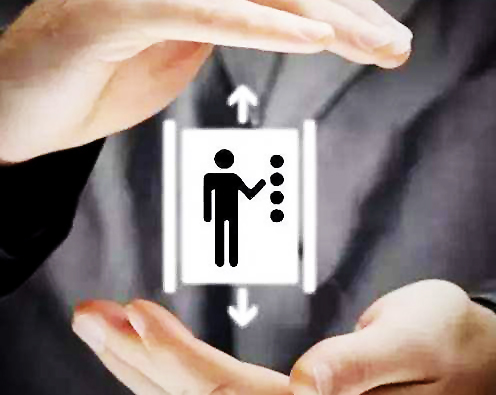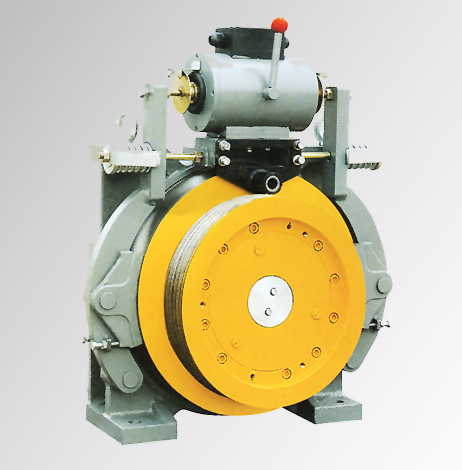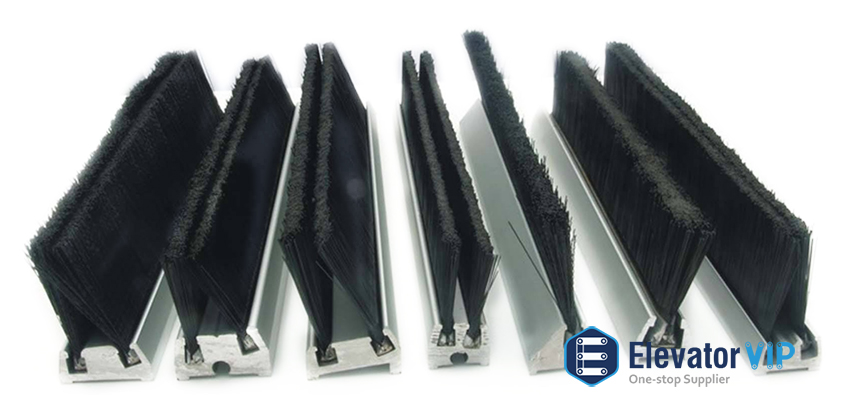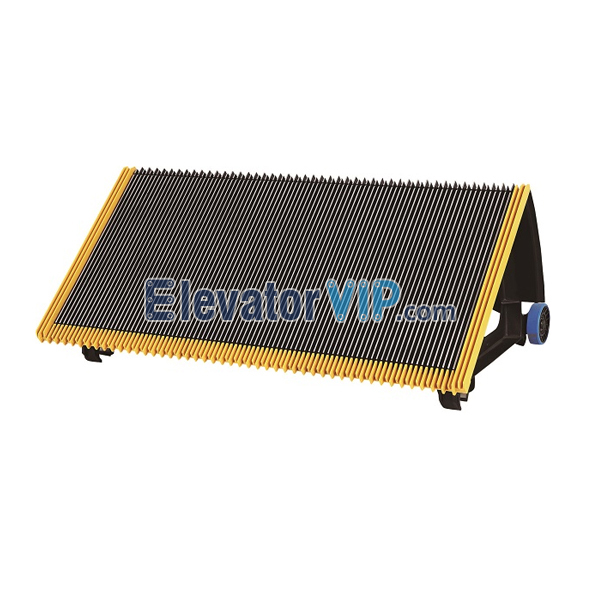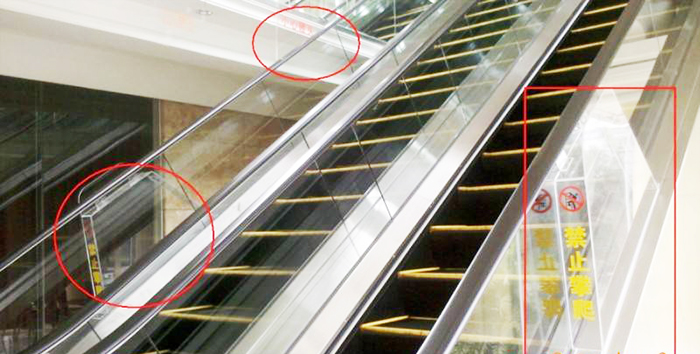1 LMCSS-MCB JFA26801AAF002 MCS 321 MCS321M-OVF30 SYSTEM
2 RCB II GHA21270A2 PLUG OUT
3 RCB II GHA21270A1 PLUG UP
4 DCSS VE GDA24350BH1
5 MAGNET SWITCH GAA177HB1 PNP
6 MAGNET SWITCH GAA177HB2 PNP
7 MAGNET SWITCH PNP
8 MAGNET SWITCH GAA177HB4 PNP
9 MAGNET SWITCH GAA177HB5 PNP
10 MAGNET SWITCH GAA177HB6 NPN
11 SPBC Board For Otis Gen2 GAA26800KB1
12 STEEL BELT SLIDER GAA385GX1
13 ENCODER PKT1030A-1024-J3OF JAPANESE TYPE REPLACED
14 ENCODER TAA663A1 ORIGIN
15 LB II
16 GPCB EA610XJ1
17 GAA24350BH1
18 RS5 GAA23550D1 ORIGIN
19 RS5 GAA23550E1 CHINA
20 RS5-C3
21 SIWEI INVERTER PCB XAA616BR1
22 SIWEI INVERTER PCB OTIS XIZI2000 MODEL-OH-5000
23 STEP GAA21640 1000/800
24 506 DRIVING CHAIN DUPLEX
25 STEP DEMARCATION GO455G1/GO455G3/GO455G4 GO455G5/GO455G11/GO455G12
26 TEST TOOL GAA21750S2 GAA21750S1/GAA21750AK3
27 506NEC BRAKE G0222P1
28 V-BELT GAA717N1
29 13VTR MACHINE
30 510 FRACTION WHEEL GO265AH OD=781mm ID=90mm BEARING:6210Z
31 HANDRAIL GUIDE STRIP GAA50AHA1 L=6000mm
32 SSGD-1L (NC)
33 HANDRAIL HEAD ROLLER GO2215P4
34 ROLLER PIN GO465BA1
35 GECB-EN GBA26800LC2/GDA26800LJ2
36 FRACTION WHEEL DAA265NNN1 456mm
37 506 SPROCKET WHEEL GAA195NV1
38 LOCK ROLLER FAA456RA1
39 AT120 DOOR POWER FAA24350BM1
40 GEN2 Head Reader with SAC (OVF20) GAA22439E12
41 18ATF Machine Encoder AAA633L1 Chinese type replaced 3 ways
42 ENCODER RKT1040-1024-C15C
43 HAIRY SLIDER FAA470E1
44 506 TESION CHAIN GAA332Z4 WITH STEEL TUBE
45 MCB3X GCA26800KV3
46 MCB3X GCA26800KV7
47 DOOR ROLLER FAA5394A50 55*16.5mm
48 INLET COVER GAA384JY1
49 INLET COVER GAA384JY2
50 INLET COVER GAA384JY3
51 INLET COVER GAA384JY4
52 INLET COVER GAA384JY5
53 Pulse transducer GAA20401A515
54 506 TESION BOX GO385EP1
55 Interlock switch GAA177GF1
56 Interlock switch GOA177BX4
57 Interlock switch GAA177HL1
58 Interlock switch GAA177HL2
59 Interlock switch GBA177HK1
60 Interlock switch XCXN2108P20C
61 Interlock Brake switch GBA177FG1
62 Key switch start-up ASW0335 IND CONT 858T
63 Interlock switch GBA1776Y1
64 INLET PLATE GAB438BNX1
65 INLET PLATE GAB438BNX2
66 STEP ROLLER GAA290CB2 76.2*22 Hole Diameter= 20.1mm
67 OPERATION PANEL GAA26220AM1
68 OPERATION PANEL GAA26220AM2
69 OPERATION PANEL GAA26220AM5
70 OPERATION PANEL GAA26220AM6
71 OPERATION PANEL KEY GAA26220AM500
72 BELT INSPECTION CSB FAA21700F1
73 BELT WHEEL GO2215AB7
74 WWPB-2 (GEN2) WWPDB GAA26810C2(GBA26810A1)
75 OTIS PCB WWPB_2 GAA26810C2
76 CEDES PHOTOCELL
77 DOOR SILL FAA483T1 L=2115mm
78 506NCE MAIN BOARD GAA26800AR2
79 506NCE MAIN BOARD CHIP
80 SPBC II GBA26800KM1
81 OPERATION PANEL GAB26220DB5
82 OPERATION PANEL GAB26220DB4
83 OPERATION PANEL GAB26220DB3
84 FLAT BELT 60mm
85 FLAT BELT 45mm
86 FLAT BELT 30mm
87 AT120 MOTOR FAA24350BL1 FAA 24350BL2
88 506 SPROCKET WHEEL GO2215AB20 OLD TYPE
89 SOM-II GAA26800AL1 GEA26800AL1
90 SOM-II GAA26800AL2
91 RSEB B9693AE1
92 RS14 GAA25005C1 CHINA
93 RS14 GAA25005B1/GDA25006B1 GERMANY
94 GAA26803A1
95 INLET W/BRUSH
96 INLET W/O BRUSH
97 506NCE V-BELT 1900mm
98 506 V-BELT 2476mm
99 510 V-BELT
100 TESION DEVICE B8669B1
101 GUIDE SHOE ROLLER 95mm
102 GUIDE SHOE ROLLER 125mm
103 GUIDE SHOE ROLLER 200mm
104 GUIDE SHOE ROLLER 200mm 2RS
105 LB-II GAA21230F2
106 LB D.9673T
107 MLB A.9673AF
108 CAN(TCBC) GDA26800KA1
109 70AMPS INVERTER BAORD ABA26800RB1
110 LIMITED SWITCH S3-B1370
111 LB-II GFA21230F1 GCA610YW1
112 MCBII W/VCR GCA26800H2
113 Otis Tape head GAA22439E12
114 push button FAA25090A111
115 LIMITED SWITCH LX26-111B
116 HANDRAIL DRIVING GAA26180D2
117 Chick let 369PB1
118 EPROM GAA30328AAG1
119 RATHGEBER 23 TEETH COMB 96003384001
120 Comb Plate G02215W8
121 Comb Plate G0453D1
122 Comb Plate G0453D2
123 Comb Plate G0453D3
124 Comb Plate G0453D4 Left
125 Comb Plate G0453D5 24T
126 Comb Plate G0453D6 23T
127 Comb Plate G0453D7 23T
128 Comb Plate G0457BF11 Power Coat
129 Comb Plate G0457BF12 Power Coat
130 Comb Plate G0A453A1 PROGRESSIVE 18T
131 Comb Plate G0A453A4
132 Comb Plate G0A453A5 PROGRESSIVE 16T
133 Comb Plate G0A453A6 PROGRESSIVE 17T
134 Comb Plate G0A453A9 PROGRESSIVE 15T
135 Comb Plate G0A453AG1 TRAVOLATOR
136 Comb Plate G0A453AG10 TRAVOLATOR
137 Comb Plate G0A453AG11 TRAVOLATOR
138 Comb Plate G0A453AG12 TRAVOLATOR
139 Comb Plate G0A453AG4 TRAVOLATOR
140 Comb Plate G0A453AG9 TRAVOLATOR
141 COMB SECURITY TEST TOOL GAA27DY1 TRAVOLATOR
142 Comb Plate GAA453BM1 24T L=203,184
143 Comb Plate GAA453BM10 23T ALU+PVC L=197,995
144 Comb Plate GAA453BM11 23T ALU+PVC L=197,994
145 23 TEETH ALU+PVC COMB L=206,39 FOR INSERT GAA453BM12
146 24 TEETH ALU+PVC COMB L=203,185 GAA453BM13
147 24 TEETH ALU+PVC COMB L=206,40 GAA453BM14
148 23 TEETH ALU+PVC COMB L=197.994 GAA453BM15
149 23 TEETH ALU+PVC COMB L=197.994 GAA453BM16
150 COMB 194,718MM GAA453BM2
151 24 TEETH ALU COMB L=206,39 FOR INSERT GAA453BM3
152 24 TEETH ALU COMB L=206,39 GAA453BM5
153 23 TEETH ALU COMB L=197,994 GAA453BM6
154 23 TEETH ALU COMB L=197,994 FOR INSERT GAA453BM7
155 24 TEETH ALU + PVC COMB L=203,184 GAA453BM8
156 24 TEETH ALU + PVC COMB L=206,39 GAA453BM9
157 24 TEETH COMB 203,184MM GAA453BV1
158 24 TEETH COMB 203,184MM GAA453BV41
159 24 TEETH COMB 206,391MM GAA453BV5
160 24 TEETH COMB 203,184MM GAA453BV51
161 24 TEETH COMB 206,391MM GAA453BV55
162 23 TEETH COMB 197,994MM GAA453BV56
163 23 TEETH COMB 197,994MM GAA453BV6
164 23 TEETH COMB 197,994MM (FOR DEMARC.INSERT) GAA453BV7
165 COMB FOR NEXTSTEP ESCALATOR (CENTER) GAA453CH1
166 COMB FOR NEXTSTEP ESCALATOR LH GAA453CV1
167 COMB FOR NEXTSTEP ESCALATOR RH GAA453CV2
168 COMB ESC.506 LG=126,945 HD2115-3
169 Comb Plate XAA453AV2 Mid/200*145*145*22T
170 Comb Plate XAA453AV3 Lefr/203*145*145*22T
171 Comb Plate XAA453AV1 Right/203*145*145*22T
172 Comb Plate GAA453BM3 Left/506
173 Comb Plate GAA453BM7 Right/506
174 Comb Plate FX453Y 127/136.5/142.8/145.8/152.3mm
175 Comb Plate A GOA453AG 127mm
176 Comb Plate B GOA454AG 146mm
177 Comb Plate C GOA455AG 152mm
178 Comb Plate GAA453BM1 CENTER/506NCE,510
179 Comb Plate GAA453BM5 LEFT/506NCE
180 Comb Plate GAA453BM6 RIGHT/506NCE
181 Comb Plate LDTJ-B-1 Plastic, Yellow
182 Comb Plate LDTJ-B-2 Plastic, Yellow
183 Comb Plate LDTJ-B-3 Plastic, Yellow
184 HANDRAIL DRIVING CHAIN GO322P100 125Pitches L=3175mm
185 506NCE HANDRAIL SUPPORT CHAIN 8 ROLLERS
186 506NCE HANDRAIL SUPPORT CHAIN 7 ROLLERS
187 506NCE HANDRAIL SUPPORT CHAIN 10 ROLLERS
188 BRAKE TAA20222BE2
189 506 STEP FAA26140A6
190 RUBBER HANDRAIL OTIS TYPE d:38+1.6 D:64±0.5 D1:82+1.5 H:35.5±1
191 DCSS4 GFA24350AW1
192 OPERATION PANEL GAA26220BD2
193 OPERATION PANEL GAA26220BD3
194 OPERATION PANEL GAA26220BD4
195 OPERATION PANEL GAA26220BD5
196 606NCT FRACTION WHEEL GAA265AT1 700MM
197 606NCT SUPPORT CHAIN GAA332Z3 10 ROLLERS
198 606NCT V-BELT POV71AAA1 L=3734MM
199 LIMITED SIWTH TAA177AH1
200 LIMITED SIWTH TAA177AH2
201 PIN ROLLER GO456AY1
202 INLET COVER GAB384NY
203 Door Controller FAA24350BK1
204 70AMPS with VA1+XU1board
205 70AMPS without VA1+XU1board
206 18ATF machine
207 AT120 DOOR CONTROLLER FAA23450BK1
208 BA610AAW1
209 ABA26800GW4
210 DOOR SKATE TECHNA
211 DOOR HANGER ROLLER 85*20-6204
212 ADA26800MB1
213 GAA26800AL1
214 GAA26800AL2
215 GAA26800AL3
216 ACA21290BA4
217 GAA25005 F1
218 GAA657 A4
219 GAA657A1(EMF4)
220 GAA2500F1
221 GAA234AJ1
222 GAA234AJ2
223 GAA234AJ4
224 GAA234AJ5
225 DOOR WIRE ROPE 4MM
226 BRAKE GO222P1 GAA20401F550 GAA20401C501
227 ROLLER FAA456X1
228 PDBII GAA26800KP1
229 Key switch for start-up ASW0335 IND CONT 858T
230 Interlock switch GAA177FW1
231 Interlock switch XCX N 2108P20C
232 Interlock switch GAA177FD2
233 Roller for step GO2215A2
234 Fuse 4A GAA375BY4
235 Fuse 1,6 GAA375AF
236 Roller for Rubber Handrail
237 Ski GO385EP1
238 Plastic cover for front skirt GAA384JY1
239 Plastic cover for front skirt GAA384JY3
240 Plastic cover for front skirt GAA384JY4
241 Plastic cover for front skirt GAA384JY5
242 OVF 30 drive (90 Amp.) ACA21290BJ2
243 OVF 30 drive (120 Amp.) ACA21290BA4
244 OVF 30 drive (120 Amp.) ACA21290BA2
245 OVF 20 CR GAA21343C1
246 TCBC GDA26800KA2 GI
247 INVERTER PCB AFA26800UD2 CONTROL TYPE OTIS 3000B.RECTRFIER TYPE ACA21290 BA4
EXPORT 325volt AC MIN 528volt AC MAX ’48-128 Ampere 50-60Hz 3phaseWiring AAA21290AY1
248 DEMARCATION LL28034032 Yellow
249 DEMARCATION LL8034023 Black
250 DISPLAY NAA20320AAA00
251 DOOR ENCODER AAA633Z21
252 DOOR ENCODER GCA633A1
253 ENCODER DAA633A1 TAA633A1
254 PCB ANSI SPEED CHECK ASCB AAA26800GG1
255 OTIS XIZI LMCS-MCB CB-II GEA21270A1
256 landing Indicator FDA23600V1
257 SERVICE TOOL GAA2175051
258 HANDRAIL DRIVING CHAIN 16B-2
259 MAIN DRIVING CHAIN 20A2
260 Poly-V belt 6J965 FAA717A1
261 Pulley for toothed belt DO2000 FBA198H1
262 Toothed belt door drive DO2000 FAA717B1 L=4400mm
263 contact “father” shunt FO156CK3
264 Contact “mother” FAA156AX1
265 Air cord OP900 FAA712X21
266 Kit of door pulley FAA198V1
267 Kit of door pulley FAA76D3
268 160VAT TRACTION WHEEL 575*5*10mm
269 SOM-A9693F
270 SOM BOARD A9693F
271 FAA177AJ1
272 AAA21305Q1
273 step XJ1200\1000\800XZ-A
274 XIZI STAINLESS STEEL DEMARCATION L48034049A
275 XIZI STAINLESS STEEL DEMARCATION L48034047A
276 XIZI STAINLESS STEEL DEMARCATION L48034047B
277 XIZI STAINLESS STEEL STEP XAA26340H3
278 apply the brake 160 VAT T0C5048b1 instead homegrown
279 CODER AAA633Z1
280 escalator driving VELT GCA717D1 Homegrown
281 LCD show FAA25100K1
282 Door roller GAA456AY1
283 GAA265NNN1
284 show JAA25140AAD102
285 GEA23550DIC product from Germany
286 constantan wire resistance
287 STAINLESS STEEL BUTTON AAA23500AM1
288 Inverter GAA225JK1
289 GUIDE RAIL GAA27078K36
290 GUIDE RAIL GAA27078K4
291 GAA177HR1 original only have 1~2 piece
292 OTIS Pacific chain(to copy Toshiba) 66.66 every node
293 escalator sensor DAA177AX2
294 Bottom guide balustrade Otis 506NCE GAA27078K83
295 GAA27078K72
296 GAA27078K78
297 braking vane EG-SW G2D90FC DAA610F1
298 Backspace guide rail GCA402BP1
299 STEP GAA26140
300 DAA25140NNN6/13
301 DAA25005A2
302 RSEB DAA26800J1 NEW
303 76.2 x 22 mm GA290AJ11
304 TCBC GDA 26800 K 10
305 MCB 3 GCA 26800 KF 10
306 DCSS 5 black box GJA 24350 BD 11 secondhand
307 PDB GDA 26800 J10
308 MCB ll GDA 26800 H10
309 button glow FAA 25090 K121
310 button glow FAA 25090 AD111
311 DRIVE CONTROL BOARD GCA 26800 AH50/5KW
312 EPRON G0161G44 FOR MCS 310-Z29
313 EPRON GOC 616G49 FOR MCS 312-Z29
314 EPRON GOD 616G34 FOR MCS 310-Z30
315 EPRON G0616G50 FOR MCS 312-Z30
316 coder FAA 633B1 FOR DO 2000
317 B module SKD 62/16
318 B module SKD 82/16
319 Transistor QM 150DY-2H
320 Transistor MG 150Q2YS40
321 Transistor MG 75Q2YS40
322 Transistor MG 150 YS40
323 Transistor MG50Q6ES40
324 DOOR CONTACT AZ14-1 KDL
325 DCSS5 GJA24350BD11 STEEL BOX
326 SHOW PCB GBA250005D1 OTISJF0003
327 Control PCB CPM2B-60CDR-DCH-CPU XIZI OTIS escalator parts
328 SWITCH LX2-412 (ZR231) LX2-412 (ZR231) XIZI OTIS escalator parts
329 DEMARCATION XAA455N1 1200R XAA455N1 XIZI OTIS escalator parts
330 DEMARCATION XAA455K1 1200 XAA455K1 XIZI OTIS escalator parts
331 DEMARCATION CN023435364 BLACK L47332092A 1000 L47332092A XIZI OTIS escalator parts
332 DEMARCATION L47332091A YELLOW 1000 L47332091A XIZI OTIS escalator parts
333 DEMARCATION XAA455Q left XAA455Q XIZI OTIS escalator parts
334 DEMARCATION XAA455R1 right XAA455R1 XIZI OTIS escalator parts
335 13VTR MACHINE the same to the spain140VAT
336 BOARD A9693D2
337 COMB PLATE XXA453BJ middle193.2*145*143 Side 214*145*142 23 tooth, in side 25tooth used in 1m step middle 23tooth it side 24tooth is used 800 step
338 3200 Controller Board RCBII GEA21270A1+LMCSS-MCB GFA26801AAF002 +OVF30-70AMPS OR OVF30-90AMPS OR OVF30-120AMPS +SOMII GAA26800AL1 OR SOMII GAA26800AL2
339 AT120 DOOR BLET CLIPS 25F-FAA23050G
340 XIZI OTSI step 53-XAA26140 the same with the GAA26140
341 OTIS step roller XAA290CY1 skeleton 76*22-6203
342 OTIS 506NEC HANDRAIL DRIVE CHAIN 16B-2
343 OTIS 506 HANDRAIL DRIVE CHAIN 16B-2 125 bitch
344 OTIS 506 HANDRAIL DRIVE CHAIN 16B live bitch
345 OTIS 506 MAIN DRIVE CHAIN 20A-2 96 bitch
346 OTIS 506 MAIN DRIVE CHAIN 20A live bitch
347 OTIS 506NEC step 1000mm silver
348 HANDRAIL GUIDE STRIP GAA50AHA1 L=6000mm
349 OTIS 506 over speed sensor
350 to drive DAA494NPA2
351 LMCSS JGA26801AAF105
352 PDB (Power Drive Board) 9kw GDA26800J10
353 PDB (Power Drive Board) 15kw GDA26800J50
354 PDB (Power Drive Board) 5kw GDA26800J20
355 ENCODER for OVF20 JAA00633ABF003 JAPANESE TYPE REPLACE
356 ENCODER for OVF30 TAA633A1 JAPANESE TYPE REPLACE
357 RS11 GBA25005A1
358 RS 14 (Remote Station 14) GDA25005B10
359 RS 18 GDA25005C20
360 LWDE FBA24270AA1
361 CPI 10 (Car Position Indicator) FAA25100J1
362 PUSH BUTTON (green) FAA25090A112 A312 button
363 DOB FAA25090J114 need photo
364 NUT FAA72N1
365 SOM Board GEA26800AL10
366 SERVICE TOOL GBA21750S1
367 Hall Button Box FAA147CH23
368 Hall Button Box FAA147CH33
369 Hall Button Box FAA147CH63
370 SPBC III GBA26800KX1
371 SPB-ANS GAA26800KS1
372 Transformer GAA225LL1
373 Transformer GAA225MR1
374 Interface Board (LVIB) 22kw ABA26800XU2
375 Interface Board (LVIB) 32kw ABA26800XU5
376 HBB GBA25005D10
377 Door Interface Subsystem C9693MB1
378 Alternate Door Interface Subsystem B9693MG2
379 DBR (Drive & Brake Resistor) GBA21295H2
380 CPI 11 (ELD Display) FAA25250C1
381 Inverter (DBSS) 32 KW,210 A ACA21290BM1
382 INVERTER BOARD ACA26800UD2
383 DCSS 5 GJA24350BD11
384 DCSS 4 GDA24350AW11 second hand 5000
385 Porter Intercom Unit FAA512AC8 FAA512V1
386 GDB GBA26800KC1 need photo
387 Processor Board ADA26800VA1
388 Battery Charger FAA628H1
389 24V KEY SWITCH FAA431E14
390 Door Encoder FAA633B1 need photo
391 friction pulley GAA265AH 781
392 Chain GO332P12
393 Chain GO332P13
394 ABA26800AKT1
395 Inverter -SIEI 7.5KW (with the gear) XAA622R18CH
396 Inverter-SIEI 11KW (with the gear) XAA622R19CH
397 Inverter-SIEI 15KW (with the gear) XAA622R20CH
398 Inverter-SIEI 18.5 (with the gear) XAA622R21CH
399 Inverter-SIEI 22KW (with the gear) XAA622R22CH
400 SIEI30KW Inverter (with the gear) XAA622R23
401 AGY11KW Inverter(escalator) XAA622Q1
402 15KW Inverter AGY3150(escalator) XAA622Q2
403 Inverter OVF20-9KW GCA21150C10
404 Inverter OVF20-15KW GCA21150D10
405 GEN2 Inverter GAA21382H1
406 GEN2 Inverter 1600KG Upon GAA21340P10
407 GW4 ABA26800GW4
408 XU1 ABA26800XU1
409 VF1 ADA26800VF1
410 VA1 ACA26800VA1
411 BA2 ACA26800BA20
412 BG1 GAA26800BG1
413 DISS JAA26805AAA201
414 ADISS (home-made) B9693MG1
415 MCB(MCSS) JGA26801AAF002
416 MCB-II GCA26800H10
417 RCB-I A9693D
418 LDB board JAA26807BAR001
419 MCB3 GCA26800KF20
420 TCBC GCA26800KA10
421 RCP JAC26801AAJ004
422 ABL001 ABA26800ABL001
423 LWB (weighing device) GAA24270AB2
424 LTB(GEN2) FAA25000E1
425 LB2(The housing ladder) GBA21230F10
426 SPBB1(GEN2) GCA26800BB1
427 BB2(GEN2) GCA26800BB2″(GBA)
428 LEM ABA26800SY1
429 RCB-II GGA21270A1
430 SOM (homegrown) XAA610AH1
431 RS-5J(import) GFA23550D1
432 ACBII (homegrown LCBII) XAA610AM1
433 SPB XAA610AC1
434 RSEB (homegrown) XAA610P1
435 LPB2 XAA610K3
436 RS-5(homegrown PCB) XAA23550A1
437 RS-5 XAA610AK1
438 AMCBI board (signal interface board) XAA610Q1
439 AMCBII board (signal interface board) XAA610W1
440 HCB board (OH1000 using) XAA610S1
441 XRDS (portal crane board) XAA24350J1
442 UX2 AAA26800UX2
443 RS13(domestic) DAA23550NNP1
444 Interfere with the absorption board(import) JBA26801AAX
445 Interfere with the absorption board(import) JBA26801AAN
446 RS-11 GCA610XA1
447 Homegrown RSAB-4
448 9693 BOARD XAA642A1
449 TO-30-LB D9673T-3
450 TO-30-IB GOA9673GP1
451 TO-30-EB-3 A9673W
452 TO-30-MLB A9673AF
453 TO-40-NPWL-LA03 N62P10005
454 TO-40-CIB GOB 9687 D1
455 TO-40-SGB JO 6840FR 3
456 TO-40-MP3 LB JO 6840RH 8
457 TO-40-MP3 LB JOA 6840RH
458 TO-40-CUBI JOA 6840FT 1
459 TO-40-TTB JOA 6840FP 1
460 TO-40-TTB JOAB 6840FP
461 TO-40-CUB2 JOE 6840FV 2
462 TO-40-CUB2 JOC 6840FV
463 TO-40-IIB JOC 6840RH 8
464 TO-40-IIB JOC 6840FS 1
465 TO-40-MIB DO 6840F 1
466 TO-40-MIB JOA 6840GC 1
467 TO-40-BAKB JOA 6840GD 1
468 TO-40-JO 610GJ N62P20105 (with 5 pieces Long capacitance)
469 TO-40-JO 6840GK N62P20104 (with 4pieces transformers)
470 TCBCZ31 CHIP GAA30084BAB031
471 LCBII CHIP GAA30083AAD1
472 ELAR-1 XAA20351C001
473 OMS (ES-SW BOARD) XAA610E1
474 Inverter Frequency division card-SIEI (APC100-1) XAA616AL2
475 Inverter expansion cards-SIEI (EXP-D16card) XAA616AL4
476 Inverter expansion cards-SIEI (EXP-E-TL card) XAA616AL8
477 Inverter expansion cards (EXP-DBSS card) XAA616BN1
478 card DO-08 XAA610AB2
479 card DI-08 XAA610AB1
480 card PG-B2 XAA616AJ1
481 Escalator microcomputer board (CPM2B) XAA616Z1
482 Reset layer safety circuit board (5000.5100) XAA610AT1
483 GEN2 coder ABA633Z21
484 GEN2 coder ABA633Z1
485 A311 coder ABA633L1
486 gearless coder (1387style) XAA633AA1
487 A411 coder A633D1
488 A411 coder AAA659C3
489 coder DO2000 (Home made) XAA633AC1
490 EC2-7main encoder GAA20401T621
491 coder (Italian speed measuring machine) XAA20500A1
492 Alloy speed measuring joint XAA648D1
493 Plastic speed measuring joint ABA215BX2
494 Light bulb 24V1W XAA417K1
495 photoelectricityE4(E3S-GS3E4) XAA177AZ2
496 photoelectricityB4 XAA177AZ1
497 escalator photo electricity XAA177AZ5
498 photo electricity sensor XAA608E1
499 photo electricity (SSGD1-L normal closed) XAA177DB1
500 photo electricity CEDES XAA177AZ3.AZ4
501 photoelectricityCRD-300N(escalator) XAA608E2
502 LAMDA3 optical screen line AAA174VZ1
503 CEDES optical screen line XAA175BL1
504 optical screen LAMBDAIII (OTIS) ABA24591T8
505 optical sensor E3JK-5M2 XBA24590G2
506 secondary contact SZ-A20 XAA156K1
507 secondary contact SZ-A22 XAA156K2
508 contact SC-N2AC110V XAA638S1
509 contact SC-N3AC110V XAA638B1
510 contact SC-4NAC110V XAA638S2
511 contact SC-5N XAA638S6
512 Fuji SC-N4 contact AC110V-80A
513 Fuji SC-N3 contact AC110V-65A
514 Fuji SC-N2 contact AC110V-35A
515 Fuji SH—4/G contact AC220V-2K2B
516 Fuji SH—4 contact AC110V-2K2B
517 Fuji SH—4 contact AC110V-3K1B
518 Fuji SH—4 contact AC110V-4K
519 Fuji SH—4 contact DC24V-2K2B
520 Fuji SH—4 contact DC110V-2K2B
521 Fuji SC-4-1 contact AC110V
522 SC-03 relay AC110V3 open 1 closed
523 SC-03 relay AC220V3 open 1colsed
524 LG relay DC24V (2open 2 closed)
525 LG relay AC110V (3 open)
526 LG relay AC220V (3 open)
527 Lgrelay AC220V (2 open 2closed)
528 220V electric power JZC1 (3TH82 4open 4colsed
529 DC24V electric power DC-DC POWER
530 relay LY2DC110V XAA613Q1
531 relay MY4Z24VDC japana XAA613S5
532 relay SH-4AC110V series XAA613B1
533 relay SH-4DC110V series 231 XAA613A1
534 break relay SC-03AC110V XAA613AB1
535 relay SC-4-1 XAA638S4
536 relay Base MY4 XAA618H2
537 relay Base LY4 XAA618G1
538 relay Base MM4XP XAA618D1
539 time relayBaseH3CR XAA618AV1
540 auxiliary contact AU-2 (1open 1closed) XAA156F1
541 auxiliary contact AU-2 (2open 2closed) XAA156F1
542 AU-4 contact XAA156J1
543 assit contactAU-1 XAA156P1
544 Power switch Z-15G-B XAA177BV1
545 Power switchZ-15GQ22-B XAA177BV2
546 Power switchZ-15GWZ-B XAA177CP1
547 Lithium battery 200HBAT09 XAA621M1
548 Lithium battery 3G2A9 XAA621N1
549 CEDES control box XAA24350AF1
550 LAMDA3 control box ACA24591R1
551 LCD SHOW 5.4 vill XAA25140G1
552 LCD SHOW 5.4vill decoding deck XAA610H1
553 transformerAT25 XAA225AJ1
554 Bottom pit repair box GEN2 DAA7004D1
555 Bottom pit stop switch box GEN2 DAA175D1
556 Emergency power supply and alarm box GEN2using DAA718A1
557 Additional power box GEN2 using DAA621E1
558 VG5 fan XAA301H1
559 11-15KW transducer fan MMF06024DS
560 22KW transducer fan5915PC22TB
561 time relay H3RDC24V without base XAA613P3
562 time relay H3CRAC110V with base XAA613AA1
563 GEN2 roller guide shoe (No three Angle board) XAA24180A1
564 GEN2 roller guide shoe (with three Angle board) XAA24180A2
565 roller guide shoe XAA456K1
566 Ultra high pressure protection switch XAA177CT1
567 filter screen XAA737B1
568 Old type feedback head (hydraulic ladder backs pan) XAA20311B001
569 Emergency drop valve XAA20301B001
570 The upside valve core XAA20301A008
571 Down valve assembly XAA20301C003
572 hydro cylinder objurgating ring BZG-100 XAA20381A018
573 hydro cylinder objurgating ringBZG-110 XAA20381A019
574 hydro cylinder objurgating ringBZG-120 XAA20381A020
575 hydro cylinder objurgating ringBZG-125 XAA20381A021
576 OTIS2000 door vane FEA24390C1
577 step lost sensor XAA177DH1
578 main roller (506step) GXF0290AR502
579 Screen copy shows ELD car ADB23750AAA004
580 Screen copy shows ELD Outside the hall ADB23570AAA001
581 ELD power AAA24591K1
582 double 8 Outside single staircase hall display (import) JAA25140AAD122
583 single 8And outside the staircase hall display (import) JAA25140AAF102
584 dual 8And outside the staircase hall display (import) JAA25140AAF122
585 single 8 Control box core (import) JAA25140AAB003
586 dual 8 Control box core (import) JAA25140AAB103
587 LANTER Landing Direction Indicator (import) AAA23500M4
588 The motor housings140VAT XAA384FN1
589 The motor housings13VTR DAA346AJ1
590 The motor housings16VAT TAA384CJ2
591 16VECDisc wheels XAA353A1
592 13VTRDisc wheels TAA290B1
593 13VTRaluminium alloy Disc wheels T0290BV1
594 13VTR trig loop 11KW DAA330E2
595 160VAT trig loop 160VAT TAA330BA1
596 18ATF trig loop TAB330AJ1
597 Brake shoe 10*100 (10*140) XHW151B1
598 Brake shoe 13VTR. 16VAT (TAB416P2) TAA416P2
599 Brake shoe 140VAT TAB416P2
600 Brake shoe 18ATF TAB486G1
601 17CT Brake shoe JY416AT2
602 hoisting cable (japana import12.7) XAA712E14
603 The composite steel belt (GEN2)1350KG using AAA717W1
604 The composite steel belt (GEN2)1350KGusing AAA717R1
605 speed limited (import) TAA20602B41
606 speed limited (used GEN2) TA20602A361
607 safety tong (used GEN2) A9672D201
608 safety tong (import) A9672E19
609 Buffer (used GEN2) FAA320BB1
610 Buffer GEN2-R2-1600KG/1. 75M/S FAA320R4
611 17CT traction machine JO260AD45
612 traction machine 18ATF TAB260B16
613 ECH3 trig loop (021) XAA20236B2
614 ECH3 trig loop (020) XAA20236B1
615 ES-SW main brake loop CSA00C021A
616 escalator sensor GO177BH
617 16VEC near the power switch
618 18ATF take off the brake wrench TAA286AJ1
619 140VAT take off the brake wrench JAA20136AAB001
620 0H5000 wrench
621 Handrails before population protection board (Emigration) GAA346PL1
622 TAA215F3 Coupling elastomer TAA215F3*TM
623 17CTHost families cover
624 12VEmergency flat device battery
625 serial interface board using for control cabinet (XAA610AE1)
626 serial interface board using for maneuvering box (FO) XAA610AE2
627 Absorb the unit SZ/Z5 XAA276C3
628 elastomeric EC-SW
629 elastomeric EC2-7
630 oleo-electrical synthetic glass XAA386BNL1
631 5Core light eyeliner XAA175AW1
632 2Core light eyeliner XAA175AW2
633 MG5AC110V relay (from tianjing) XAA638AK1
634 Button XAA323AK1
635 ButtonBR27 (Home made) XAA323S1C
636 ButtonBR23 XAA323G4
637 ButtonBR34A XAA323N1
638 ButtonBR34 (First letter) $X/XAA323N1
639 BS34 button (First letter) $X/XAA323P1
640 pitch button (OH5100)
641 button BR54 XAT999A40
642 button BS34A XAA323P1
643 A313 button
644 OTIS-40 button
645 stainless steel with the Braille (-1—9)
646 BR34 button character
647 BS34 button character
648 BR27 button number character XAA323BE1A
649 import BR36 button (hair line stainless steel) XAA323Q1
650 import BR36 button (mirror faces taintless steel) XAA323Q2
651 import BR36 button (titanium) XAA323Q3
652 import BR27 button (mirror face stainless steel) XAA323L2
653 BR27hair line stainless steel button XAA323L1
654 BR27Without the bottom box button XAA323BQ1
655 England key-stroke XAA323AA1
656 BR27 Press the elliptical character sheet (hair line) XAA323D1/D2
657 keypad (mirror face With Braille) XAA323D2
658 GEN2 The base station lock FAA431B1
659 Operate box hook lock (passenger-goods lift) XAA431J1 XAA431AA2
660 electric door lock 21VF XAA431H1
661 electric door lock (DS-4) XAA431Z1
662 power switch (six pin) XAA177T1
663 power switch LX29 XAA177AP1
664 power switch PB78 XAA177CB1
665 power switch UKS XAA177BH1
666 power switch UKT XAA177BL5
667 door lock over travel-limit switch X2-11 XAA177AP2
668 fireman switch (single. ordinary) XAT999A22
669 Bitable magnetic switch KCB XAA177AS1 (XAA661G1)
670 limited power switch EL-1375 XAA177DA1
671 EL1376 power switch XAA177EC1
672 safety tongs switch XAA177BL1 (TAA177AH)
673 screen show ELD (6.4inch XAA25140E3
674 screen show ELD (8.4inch inside car) XAA25140AC1
675 screen show ELD (8.4inchOutside the hall) XAA25140AC2
676 single 8 Control box core21VF XAA25140AAB201
677 dual 8 Control box core21VF XAA25140AAB202
678 single 8group control Outside the hallINTER-MACHINE21VF XAA25140AAF002
679 single 8horizontal typedisplayINTER-MACHINE21VF XAA25140AAA002
680 dual8singlestairOutside the halldisplayINTER-MACHINE21VF XAA25140AAD022
681 dual8group control Outside the halldisplayINTER-MACHINE21VF XAA25140AAF022
682 dual8horizontal typedisplayINTER-MACHINE21VF XAA25140AAA022
683 411cardisplay
684 XO/dual8 parallel connection Codified board (two-in-one) XAA23550A5
685 XO/single8 Codified board Chinese (two-in-one) XAA23550A2
686 XO/dual8 Codified board Chinese (three in one) XAA23550B4
687 dual8 Codified board Chinese (two-in-one) new type
688 XO/single8 Codified board English (dual tier) JAA25140AAC102 (upgrade type)
689 XO/single8 board Chinese (dual tier) JAA25140AAD106
690 XO/dual8Codifiedboardchinese (dual tier) XAA25140AAD022
691 XO/dual8parallel connection Codified board English (dual tier) JAA25140AAD126
692 XO/dual8parallel connection Codified board English (dual tier) XAA25140AAF122
693 XO/dual8Codifiedboardchinese (two-in-one) XAA23550A3
694 XO/single8parallel connection Codified board Chinese (two-in-one) XAA23550A4
695 XO/single8Codifiedboardchinese (three in one) XAA23550B3
696 No bottom box dual eight display
697 No bottom box single eight display
698 2 in 1 display displayXAA23550A2
699 single8dual8group control display board (three in one) XAA23550B1.B2
700 single8maneuvering box display (three in one) XAA25140AB1
701 dual8maneuvering box display (three in one) XAA25140AB2
702 singlestairsingle8display XAA25140V1
703 singlestairdual8display XAA25140V2
704 car display – dual8 XAA25140K1
705 Outside the hall display – dual8 XAA25140L1
706 XAA23500D9
707 XVFsingle8Codifiedboardchinese (three in one)
708 dual8Codifiedboardchinese (three in one) DAA25140NNN6
709 dual8Codifiedboardchinese (three in one) DAA25140NNN14
710 dual8Codifiedboardchinese (three in one) DAA25140NN6
711 dual8Codifiedboard (three in one) DAA25140NNP10 (English)
712 dual8parallel connection Codified board Chinese (three in one) DAA25140NNN2
713 dual8parallel connection Codified board (three in one) DAA25140NNP14 (Chinese)
714 single8parallel connection Codified board Chinese (three in one) XAA23550B1
715 single8Codifiedboardchinese (three in one) KEY
716 emergency supply DC-12V XAA621J1
717 permanent magnet relay XAA613AN1
718 interphone 934B XAA25301G1
719 one to others Intercom channel5050HZ XAA25304B2
720 interphonemainframe1 by 1mainframe202 XAA25302A3
721 HDZ-30011by 1mainframe XAA25303A1
722 1 by 1mainframeHDZ-4001 XAA25305A1
723 The three of intercom GEN2mainframe XAA25301H11
724 GEN2interphone House to pay the machine XAA25301H2
725 1by 5mainframeHDZ-4005(5set) XAA25305A2
726 HDZ-200D2 electric power XAA25302C1
727 HDZ-200D3 electric power XAA25302C3
728 HDZ-200D4 XAA25302C2
729 five orientations talkback power strip XAA25302G1
730 1to 5machine tools XAA25302A2
731 1to public machine toolsHDZ-980A XAA25304A1
732 HDZ-980 public machine tools XAA25304A3
733 five orientations talkback mainframe XAA25302A6
734 talkback donkey engine talkbackHDZ-3001F XAA25303B1
735 talkback donkey engine talkbackHDZ-300FA XAA25303B2
736 talkback donkey engine talkbackHDZ4001F XAA25305B1
737 talkback donkey engine talkbackHDZ-201FA XAA25302B3
738 talkback donkey engine talkback XAA25302B5
739 five orientations talkback XAA25302B6
740 GEN2talkbackdonkey engine talkback donkey engine talkback XAA25301H10
741 Its top car bottom talkback donkey engine talkback XAA25305B5
742 4001 type talkback donkey engine talkback XAA25305B4
743 talkback power XAA25302F1
744 single phase power Filters HL-06D
745 rectifier bridge AC31V=DC28V
746 transformer 220=DC105V
747 transformer (XAA225BF6) 400=DC28/10A.AC24/9A.AC110/5A.AC220
748 transformer (XAA225AS1/AS2) 400=DC28/10A.AC24/9A.AC110/5A
749 transformer (XAA225BA1) 400=DC110.AC24.AC110
750 transformer (XAA225AQ1) 400=DC28/10A.AC24/15A.AC110/5A
751 transformer (XAA225AC1) 400=DC110.AC24*2
752 transformer (TDB-800-06) 380=AC122.AC72
753 transformer (TDB-1020-01) 400=DC165*2
754 transformer (XAA225AM2) 400=DC110.2,5A/AC110V/AC24V
755 transformer (goods elevator TDE-142) XAA225P4
756 transformer TDE-101(36V) XAA225P1
757 transformer TDE-102 XAA225P2
758 transformer TDE-521 XAA225R1
759 transformer XAA225AS1
760 transformer 5100 XAA225AS2
761 transformer ACVV380/220 XAA225AG3
762 transformer XAA225AM2
763 call box double/and with fire-control/middle/BR34A XAA23500FD10-A (hair line)
764 call box double/and/with fire-control/below/BR34A XAA23500FC11-A (hair line
765 call box single /and/without fire-control/middle/BS34A XAA23500EK2-A
766 call box double/and/no/The basalBR34A XAA23500EH10-A
767 call box double/single/no/stratum basale BR34A XAA23500ED10-A
768 call box single/single/no/In the basetierBR34A XAA23500EE1-A
769 call box double/single without/middle/BS34A XAA23500EA11-A
770 call box single/single/toplevelBR34A XAA23500EB1-A
771 call box single/single/mesosphere/BR34A XAA23500EA1-A
772 call box BS34Asingle8 show middle (Plastic bottom box) XAA23500EA11A439
773 call box BR34Adual8 show middle (Plastic bottom box) XAA23500EA10A439
774 call box (house stair top tiersinglebuttonBR23) XAA23500AE3
775 call box (house stair middle tierdualbuttonBR23) XAA23500AE5
776 call box(XHW middle) XAA23500GC9
777 HPBcall box XAA23500R2
778 HPBcall box XAA23500S2
779 HPBcall box XAA23500X2
780 call box(horizontal typedisplaydual8) XAA23500D5
781 maneuvering box cranberry glass XAT999A34
782 escalator synthetic glass
783 fire-fighting synthetic glass XAA147AQ1
784 IC card XAA616AL1
785 card-reader-Outside the hallRFC08 XAA616AK2
786 card-reader-Outside the hallRFC07 XAA616AK3
787 read-punch read in machine XAA616BG1
788 car top inductor (GEN2) GAA177BH5
789 rope hand (to weith system) XAA386AXT
790 to weith system ZCW-2000+ XAA24274B1
791 to weith system DZKDD-1X-W35 XAA24275B1
792 passing chime21VF XAA311G1
793 passing chimeXVF XAA311H1
794 E311Outside the hall passing chime bottom state XAA269F3
795 electric bell 220V XAA311F1
796 electric bell DC12V XAA311F2
797 pit power switch1A XBA177BN2
798 pit power switch1B XAA177BN6
799 annex power pack. XAA308GV1
800 car top check box STAR.OH5000.FOVF XBA24830D1(XAA24831A4)
801 car top check box21VF XBA24830D2
802 car top check boxMCS220M XBA24830D3
803 car top check boxMCS321 XBA24830D4
804 car top check box HOME-LIFT XBA24830D5
805 car top check box XHW XBA24830G1
806 car top check box LCBII hydraulic pressure XBA24830G2
807 car top check box FO goods elevator XBA24830G3
808 copper core1.13 XAA175R2
809 copper core10 square XAA175AC1
810 screening wire RVVP9*0.12 XAA175N4
811 6core screening wire XAA174K7
812 round cable 7core XAA174Y1
813 cable 9 core multiple twin XAA174Z1
814 cable 32 core(with the screen) XAA174AB4
815 cable 39 core XAA174Y8
816 surname cable 36core (without the piug-in) XAA174D2
817 retinue cable 22*0.75+2*0.25 (GEN2) FAA25500S999
818 electron arc suppressor XAA605A1
819 140W22 ohm age XAA617B10
820 140W320 ohm age XAA617B11
821 pressure-sensitive resistance XAA617D1
822 1KW80 Ohm resistance box XAA21305A4
823 trig resistance box 1500W100 ohm (2 pieces parallel connection) XAA21305A5
824 trig resistance box1500W20ohm (4pieces parallel connection) XAA21305C1
825 trig resistance box1200W28ohm XAA21305C7
826 trig resistance box2000W11.6ohm XAA21305D1
827 trig resistance1500W3ohm XAA232Y2
828 trig resistance1000W100ohm XAA232W2
829 resistance piece 1.95 ohm XAA232D1
830 resistance piece 2.80 ohm XAA232AV2
831 4hole oblate plug XAA618AB2
832 anti-riot light (Light plane ship) XAA417N1
833 Buzzer 21VF XAA731A1
834 Buzzer24V XAA731C1
835 calculagraph HLTC220V XAA630J1
836 crosscurrent fan (high power) (422A) XAA24720J2
837 crosscurrent fan (lower power) XAA24720J1
838 square fan XAA24720E1
839 air outlet 463×43、open holes 483×93, 40W car fan
840 air outlet 450×43、open holes 473×93, 40W car fan(1042)
841 air outlet 268×43、open holes 383×93, 40W car fan(9B)
842 car fan(goods elevator)
843 transform power switch (car top) XAA323AC2
844 three open one closed transform power switch XAA323AF6
845 control box read small button XAA323K1
846 car door power switch XAA177BC1. BD1
847 hot protector XAA613AR1
848 phase sequence encoder ABJ1-122 XAA613AT2
849 ring-shaped strip lamp XAA417E2
850 rocker die (whole plastic) XAA237F1
851 triangulation chain core around XAA431AB2
852 triangulation key XAA431AB1
853 Unloading rod XAA431AB3
854 guide shoe inside shoe lining XWP243C2 XAA237D
855 shoe guide (Mitsubishi 120*16) XAA380N1
856 shoe guide (mitsubishi120*10) XAA380N2
857 shoe guide 120*17 XAA380G1
858 shoe guide220*17 (XAA256J3) DTJ1501-3
859 GEN2shoe guide (splint) FAA380F500
860 roller guide shoe guide XAA380K1
861 oil cup XAA349C1
862 Guide shoe (Mitsubishi) XAA2416+1B1
863 Guide shoe (with the metallic reed) XAA24161A1
864 hydraulic pressure elevator roller guide shoe XAA24186A1
865 GEN2 car guide shoe XAA237J1
866 guide shoe 1.75M/S XAA237D2
867 passive door lock XAA177CR1
868 door lock 10.4around XAA431Y1
869 PB-D16 door lock
870 door lock161 XAA431R1
871 sundries elevator door lock XAA431G1. G2
872 hall door shock leather XAA320AB1
873 shockproof piece (escalator enter) XAA310YE1
874 Heavy steel wire rope M=900MM XAA712X1
875 Blade rubber wheel XAA290DA1
876 roller (Swinging rod hanging round) XAA290BW1
877 roller 203 XAA290BX1
878 621 roller with the axis XAA290BV1
879 eccentric XAA502K1
880 belt 1120 XHW260A1
881 belt1400 XHW260A2
882 1460 triangle belt XAA717H2
883 1420 triangle belt XHW260B1
884 test speed velt XAA717G1
885 fag end assemble 13 XAA20771D131
886 12 fag end assemble XAA20771B121
887 sound insulation sheet rubber XAA310E4
888 plastic rubber sheet XAT995A10
889 copper sheathing 19KW XAA465BT1
890 double XAA24550C26-36
891 safety connect board (Chinese type) XAA24550B1
892 the alum sill 55 W M=800, 900 XAA426F2. F3
893 the alum sill 75 W XAA280A6
894 door vane038 XBA477P1
895 door vaneDO2000 XAA477E3
896 electric motor 123W XAA20500H2
897 electric motor 177W XAA20570L1
898 electric motor XRDS XAA20500H1
899 Expanding system (air stairs) XBA22710B1
900 Expanding system (escalator) XAA26183R1
901 Expanding system GEN2-X XAA22717A2
902 Mention knife block XAA385Y1
903 stainless steel a unit cards XAA102R9
904 titanium single plate XAA102R11
905 stair Disc wheels
906 J1.1mainframeretraint coil
907 J1.1mainframeretraint coil(dual) XAA175BM1
908 OH5000retraint coil
909 OH5000 Brake Base XAA293L12
910 13VTRoil seal 80*55*12 XWQ281C1
911 17C oil tight JAA00033AAB1
912 17C oil tight 73*49*10 (XWQ281D2) JAA00033AAA1
913 240mainframeoil tight XWQ281B1
914 60HT brake shoe
915 blower capacitance ACVV XAA226S1
916 draught fan INTER-MACHINEACVV XAA301J1
917 160VATmainframe draught fan TAA600E2 (XAA301G1)
918 elevator ca air conditioner TK-22Y XAA24720D1
919 cover board special nut GAA72BT1
920 special nut (elevator) XAA72X1
921 4*16stainless steel nut
922 equipment room jiack box 80A (tianjing) XAA177BX3
923 car door pendant 900 (XAA389AP4/10.1000) XAA389AC1
, 924 compen sating chain 1.23KG/M XAA332K12
925 compen sating chain1.47KG/M XAA332K15
926 compen sating chain1.49KG/M XAA332L15
927 compen sating chain1.99KG/M XAA332K20
928 compen sating chain2.23KG/M XAA332L22
929 compen sating chain guide system XAA22801C
930 spring buffer DTJ1702 (1000KG) XAA90AB1
931 spring buffer DTJ1703 (5000KG) XAA320F3
932 spring buffer DTJ1704 (2000KG) XAA320F2
933 spring buffer DTJ1705 step H=305 XAA320F4
934 overrunning governor XAA20601A4
935 overrunning governor XBNA20607A4
936 safety tongs AQ1.0.63-1.75M/S XAA24122A14
937 safety tongs AQ2 XAA24122D1
938 safety tongs QJB2500 (0.63-1.75M/S) XAA24121A4
939 hydraulic pressure buffer 1M/S XAA320E13
940 hydraulic buffer 2M/S XAA320E14
941 polyurethane bufferZDQ-C-6 XAA320F13
942 counterpoise roller DTJ1604A XWP232B1
943 530-4*13 counterpoise roller XAA256N2
944 530-5*13 counterpoise roller XAA266N3
945 520-4*13 counterpoise roller XAA266N4
946 520-3*13 counterpoise roller XAA266N5
947 escalator advancing front board (middle board 1580*470) XAA457BA1
948 directive wheel DTJ0501 XWP230A1
949 directive wheel 560DTJ0504 XWP230B1
950 directive wheel 560- (6*12) DTJ0509 XWP230C1
951 directive wheel parts XAA20751H13
952 car top roller system 560-3-13 XAA24061K2
953 car top roller system 520-4-10 XAA24061K3
954 car top roller system 520-5-10 XAA24061L1
955 car top roller system 560-5-10 XAA24061L2
956 teaction machine 3-13700 (13VTR) TAA260H1
957 teaction machine roller 5-13-610 XAA260E1
958 teaction machine roller J1.1 $X/XAA260F1
959 controller door hinge XAA391E1
960 landing door system (dual pull down type1500) XWP210AG1
961 landing door system (dual pull down type1800) XWP210AN1
962 Chinese dual type landing door system M=2800 XWP210CS1
963 Chinese dual type landing door system M=2600 XWP210CD1
964 Upper can Alyssa stroke 600-1200MM XWP206AA1
965 Beside the hom opened dual type 700-1500MM XWP206AB1
966 hall door upper sill M=900 XWP206B1
967 GEN2The upper sill box OP=900 XWP206L1-2
968 M=800 The upper sill XAA409AL4
969 Stroke double door folding machine (including control panel) XWP211Z1-1(OP=2600)
970 M=1500 Double folding door machine system (including control panel) XWP211G1-1
971 Counterweight rack 520-3*13 XAA25701H15
972 Counterweight rack (without counterweight parts) XAA25705C1
973 Counterweight rack (including counterweight parts) FAA25700CC1
974 without door frame glass car door 900*2100 XAA24770B
975 without door frame glass car door 900*2100 XAB24470B6
976 without door frame glass car door 900*2100 XAA23100B
977 with door frame glass car door M=900*2100 XAB23100A6
978 tour glass (one piece) moisture by 3 pieces $X/XAA24700.0.1
979 paint OTIS XWQ201B4
980 OH5000 encored line
981 yellow hurried Stop retainer XAA137AE1
982 Double 8 And ladder call panel
983 U style filler block
984 25 tooth double chain roller ES2.2.1-1(XAA195X2)
985 29tooth Harvard chain roller PNS1.1-1
986 1000 actuating shaft (with 25 tooth 31tooth chain roller) XWP260G3
987 contact roller (with roller) 10part XAA332X1*
988 escalator overhaul box cable L=25m sidewalk XAA26220AA4
989 escalator overhaul box cable L=9m XAA26220AA5
990 filter 42TDVST2 XAA657H2
991 75TDVST2 filter XAA657H4
992 1000UF capacitance
993 escalator overhaul plug XAA618AX1
994 edge warping guide plate pack parts XWP213E3
995 used in side work entrance outside decorate XWP262C9
996 entrance decorate XWO262C7
997 stainless steel entrance decorate XWP262C3
998 leading edge board (middle board/508step) XAA457BX1
999 leading edge board (comb 508step) XAA453AG1
1000 sidewalk long sleeve XAA81H1
1001 sidewalk shirtsleeve XAA81J1
1002 bearing direr XAA304AT1
1003 toe guard M=800 XCA281G3
1004 compensating chain direct system (metallic conduit) XAA392D1
1005 step A set of hanging scrolls prevention XAA316CY1
1006 down R brush bracket XAA402QQ1/2
1007 straight line brush bracket XAA402QM1
1008 HOLDERPROFOLE brush proximate matter GAA402CES1
1009 up R brush bracket XAA402SR1/2
1010 ENDCAP tip brush proximate matter GAA273WJ1
1011 BRUSH head brush GAA241G1/2
1012 flat bed flashboard bracket XBA347PP1
1013 sidewalk main wheel
1014 electromagnet MFZ1-4.5 XAA233D1
1015 bed junction box XAA308FV1
1016 core Shock absorption plate XAT997A15
1017 step baffle XAA386AJK
1018 step baffle 1000 sidewalk XAA386APZ
1019 railing test the speed sensor XAA177CD1
1020 rope clamp XAA20650B
1021 lower extreme place skirting XAA438SJ21-OUTDOOR
1022 down equipment room switch board in common usage electrical element XAA26202AQ3
1023 angle modulation bracket XAA417AH3
1024 railing to drive -third class horizontal ladder XWP260F25
1025 sill module 1800 Stroke double XBA426L7
1026 landing door system M=1800 Stroke double XWP210BV1
1027 protective guard 2pcs XAA24030A1
1028 protective guard 3PCS XAA24030A2
1029 VFBDS control box XAA308BJ1
1030 SELCON swing door control box XAA24350AD2
1031 operation 21VFBR27 button (Home-made) 10/10 XAA313H10
1032 operation XHW5/5 XAA25000C16
1033 GEN2 car top wire connector XAA25402A1
1034 take off the brake helper ACVV XHW155A1
1035 step bracket FT30°C FT11-7(35°C0103-10)
1036 swing door system (DO2000M=900MM)
1037 swing door system (XRDSM=900MM) without DISS
1038 swing door system (XRDS in common usage pieces) XAA27076F
1039 car (1600*1600MM spray-paint)
1040 Double folding door pocket (1800 stainless steel)
1041 door pocket (Big B style . stainless steel)
1042 door pocket (stainless steel M=900MM) XAA23141A49A439
1043 door pocket (little spray-paint M=900MM)
1044 Double folding car (stainless steel M=1500
1045 Double fold the hall door fastening piece XWP210FC1
1046 Double folding car M=1500
1047 Double folding medicine ladder marks stainless steel car XWP211CS21(OP=1500*2400)
1048 Double folding door (stainless steel M=1500) XWP210EK9
1049 Stroke double folding door – right shutter M=2600 XAA413AC45
1050 Stroke double fold hairline stainless steel XWP210EQ13(2400*2400)
1051 Stroke double folding elevator door XWP211DQ15(OP=2600*2600)
1052 Stroke door (stainless steel) M=900
1053 Stroke type door lamp square tube M=900stainless steel
1054 Stroke door (stainless steel) M=900 XWP210EY3
1055 White mirror stainless steel Hall door (bare door) XWP210EZ12-1(OP=900)
1056 Titanium mirror stainless steel Hall door (bare door) XWP210FB9-1(OP=900)
1057 Stroke door (iron plate) M=900
1058 REM RMON XAA21200B1
1059 Stroke double fold door OP=1800HH=2100 XWP210ES7
1060 Stroke double fold door cover HH=2100OP=1800 XAA23195D22A
1061 switch board (FO package 11KW) XWP100AT3
1062 switch board (STAR-11KW) XAA21290BA3
1063 switch board (STAR-15KW) XAA21290BA5
1064 switch board (STAR-CON90A)
1065 switch board (STAR-CON120A)
1066 switch board (OH5000) 11KW
1067 switch board (escalator B-package) XWP150A2
1068 switch board 300VF90A XAA21290K1
1069 MCS220-GEN2 norm switch board (OPT2) GAA21000BY1
1070 508escalator . Sidewalk frequency conversion switch board XAA26202AN6
1071 508escalator.Sidewalk norm switch board XAA26202AN7
1072 Traction machine (without the tooth) 9.5KW XAA20220A1
1073 without the tooth traction machine 6KW XAA20221A220
1074 Traction machine 13VTR11KW D13VTR109
1075 Traction machine 13VTR14KW D134VTR111
1076 Traction machine 160VAT15KW TAB20003A361
1077 Traction machine 16VEC11.7KW XAA20010A2
1078 Traction machine 17CT XAA20021S3
1079 Traction machine 17CT XAA20021S2
1080 Traction machine 18ATF TAD20000A539
1081 Traction machine 18ATF D18ATF102
1082 Traction machine ECH3 GAA20401C/11
1083 Traction machine ECH3 GAA20401C/8
1084 Escalator Traction machine 16VEC XAA2001A1.A2
1085 Escalator Traction machine EC2-7 9.5KW XAA20401A5
1086 Escalator Traction machine EC-SW 7.5KW XAA20400B1
1087 Escalator Traction machine EC-SW 9.5KW XAA20400B2
1088 Traction machine 60HT Power 30KW XAA2001AE16
1089 Traction machine 60HT Power 15KW XAA2001AE12
1090 GEN2-R1 Traction machine AAA20220AK5
1091 lifeline
1092 lifeline bracket
1093 summer work clothes
1094 shorting stub
1095 triangle lock label XAA102DP1
1096 saddlebag
1097 squiggling tool XWH260C2
1098 creep age protector XWH260C3
1099 car door retainer
1100 escalator opt-electrical XAA177ES1
1101 car top junction box XAA24830E1
1102 fireman box XAA23851B1A439
1103 fireman box (the newest) XAA23851D10
1104 time limited XS1-25(电碰吸铁) XAA20300E1
1105 cooler XAA713B2
1106 cooler digital display temperature controller XWL616A1
1107 piezoelectric type sensor GAA177GZ1
1108 Siemens trophies protector XAA613AX1
1109 fag end shield XAA384HF1
1110 metal strip detergent $X/VP-420540
1111 escalator Connect the tubing 2.6m XAA134D10
1112 annex arrester (electromagnetic arrester) XAA26220E1
1113 escalator with magnetic white riding wheel GAA456DK1
1114 508 escalator The partial article GAA385GF1
1115 STAR escalator the partial article XAA385A1
1116 multifunction upright post (with traffic flow rate light) XAA26620A1
1117 VF-7Fswing door transducer XAA622AB1
1118 68#resistance to wear hydraulic medium XWQ284A1
1119 508 escalator inlet inside (stainless steel) XAA402VX9
1120 508 escalator inlet inside (stainless steel) XAA402VX10
1121 L-style bracket XAA283JD1 XAA286GL1
1122 LCBII plank plug-in XAA618AT3
1123 groceries step hall (with doorframe stainless steel) XAA23371A12
1124 groceries step hall (stainless steel) XAA412A12
1125 escalator middle prop up 250 high XAA26220F5
1126 new STAR.XOP entrance outer flank left XAA396X101
1127 new STAR.XOP entrance outer flank right XAA396X102
1128 new STAR escalator entrance inner side left XAA396W101
1129 new STAR escalator entrance inner side right XAA396W102
1130 new XOP entrance inner side left XAA396W105
1131 new XOP entrance inner side right XAA396W106
1132 chip yard (02CV640TO) SM-02-V3.2
1133 SM-02-EXT-V3.1
1134 RS5J2
1135 Bottomless box machine station lock, fire-fighting button box
1136 XIZIOTIS key power switch
1137 LAY37(PBC) key power switch
1138 OTIS steel casing limited power switch
1139 The wheel–jumpiness’ style;side walk XWP261B1
1140 508 step S style XAA50CF1
1141 down flat bed inside cover board XAA402TH5
1142 escalator proximate matter–8# backbone XAA50D1
1143 ARMASSEMBLY swing stem structure XAA288N9
1144 up flat bed inside cover board (439 material) XAA402TG17
1145 SL item inside cover board (439 material) 508escalator XAA402TJ997
1146 up R outside cover board508 XAA402WF49/50
1147 SL-outside cover board-panel strip XAA402DQ1
1148 up R skirt deck 439508 escalator XAA438K1
1149 up skirt deck 439 (508 escalator) XAA438SH1
1150 180 standard railing bracket XAA316ACL1
What is the Elevator PLC?
Elevator is an important means of transportation in modern buildings, which is related to the safety of people’s life and property How to improve the efficiency of elevator operation, reduce energy consumption of elevator, reduce mechanical wear and prolong the service life of elevator are all very important research topics. Elevator is a complete set of equipment used for fixed elevations in floors. It has characteristics of safe, reliable, comfortable, accurate, easy to operate and transportation efficiency. It consists of lifting traction system, guiding system, safety device and electric control system.
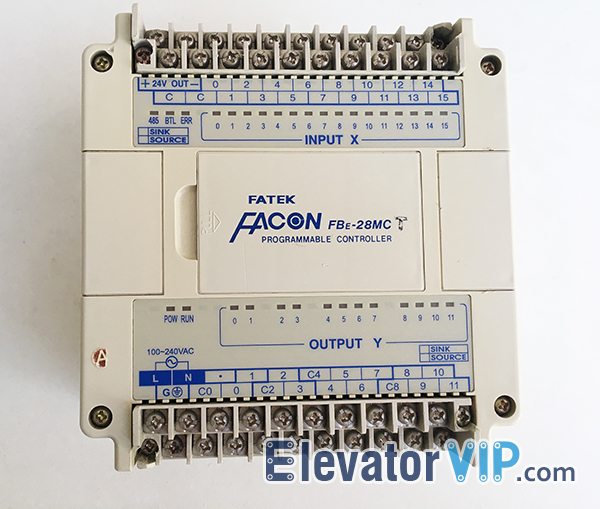
FATEK FACON FBE-28MCT PLC, FATEK FBE-28MCT Supplier, Cheap FATEK FBE-28MCT, FATEK FBE-28MCT Online, FBE-28MCT PROGRAMMABLE CONTROLLER, second-hand FBE-28MCT PLC, used FBE-28MCT PLC, wholesale FATEK PLC
At present the elevator control widely adopted two ways, one is using microcomputer as signal control unit, to complete the elevator signal acquisition, running status and the function set, realize automatic scheduling and collection operation function of the lift, drag the control are done by frequency converter; The second control method USES PLC (Programmable Logic Controller) instead of microcomputer to realize signal set selection control. In terms of control mode and performance, the two methods are not much different. Most domestic manufacturers choose the second method because of the small scale of production and the high cost of designing and manufacturing microcomputer control devices. PLC has high reliability and flexible program design. This design USES Mitsubishi, FX2 series PLC to control the displacement sensor of static magnetic grid to control the elevator flat layer.
How to use the elevator safely (Elevator Safety Knowledge)?
How to use the elevator safely (Elevator Safety Knowledge)
ONE- civilized waiting for the elevator
- Correctly press the up or down buttons at the door, not both at the same time. If you press the up or down button at the same time, it will make the elevator useless and waste the waiting time and electricity. When the elevator arrives, if there are multiple parallel elevators, the arrival lights of any one of them shine and the arrival bell rings, inviting you to wait at the entrance.
- After the elevator closes, passengers first go down and then go up. If any passengers come out of the car, you should stand on both sides to facilitate their evacuation and then enter the car.
- If the car is full, please wait patiently for the next elevator to arrive.
- When the elevator closes, don’t push your hands or other objects between the two doors
- In case of fire or other circumstances, people in the building shall evacuate through the stairway. Do not take the elevator, in case the power of the elevator is damaged, taking the elevator will be trapped in the car.
TWO- Correct access to the elevator car
- Get in and out of the car quickly and safely, do not stay at the door. Passengers standing at the door should leave the car first.
- Press the destination floor button correctly to ensure you can reach the aim floor.
- If the number of passengers in the car is moderate, you can move deep into the car to facilitate other passengers.
- Passengers with children need to take good care of children, and passengers with pets should prevent pets from moving alone.
- Keep a distance from the elevator door. When open and close door, special attention should be paid to prevent clothing or personal belongings from being crowded by the elevator door.
- If you need the elevator door to keep open, you should hold down the open button. If you need to carry your belongings, you can ask other passengers to hold down the open button
THREE- Take the elevator correctly
- Pay attention to check the elevator on the presence of << safety inspection >> label, and whether in the period of validity, don’t blind to take elevator such as do not conform to the requirements of the elevator equipment, to reflect the local Special Equipment Safety Supervision Department.
- Stand as close as possible to the wall of the car and put your hands on the car arms if elevator with it.
- Most elevator injuries occur at the door or in the hoistway. When the elevator fails, stay away from these two positions can keep you safe.
- The elevator door (the floor of the car door) is a very dangerous place and cannot stay for long
- Try to get in and out as quickly as possible, and don’t linger between the door and the door. Don’t lean against the elevator door or floor door while waiting and riding
- Gently press the call button or choose the operation box car floor layer button, indicator, quietly waiting for the elevator, don’t jump in the car, or with hard, sharp tap button or press the button again and again, and may not hinder the movement of the door by hand or by body
- Attention should be paid to the handling of articles. For transparent objects such as glass, when entering or leaving the car wearing thin long skirts, high heels and carrying umbrellas, careful attention should be paid to the accident caused by clamping.
- Do not carry inflammable, explosive or corrosive dangerous goods in the elevator.
Everything you should know about elevator brake
The elevator brake generates two-way electromagnetic thrust when electrified, which makes the brake mechanism separate from the rotating part of the motor. When the power is off, the electromagnetic force disappears. Under the action of the applied brake spring pressure, the friction-type brake of the electric loss brake is formed. It is mainly with escalators traction drive motor on formation of escalator with electromagnetic brake three-phase asynchronous motor, widely used in parking can achieve smooth and rapid start and brake when electricity safety.
Brake is an important safety device of elevator. Its safety and reliability is one of the important factors to ensure the elevator running safety.
The working principle of elevator brake
When the elevator is at rest, no current passes through the coil of the traction motor and the electromagnetic elevator brake. At this time, because there is no attraction between the electromagnetic iron core, the brake pad tightens the brake wheel under the action of brake spring pressure to ensure the motor does not rotate; The moment when the traction motor is electrically rotating, the coil in the brake electromagnet is connected with current at the same time, and the electromagnetic core is magnetized and absorbed rapidly, driving the brake arm to force its brake spring, the brake tile is opened and completely separated from the brake wheel, so that the elevator could be running; When the elevator car stop the required floor, the traction motor loses power, and the coil in the brake electromagnet also lost power , and the magnetic force in the electromagnetic core disappears rapidly. Then the core is reset by the brake arm under the action of the brake spring, make the brake tile hold the brake wheel again and the elevator stops running.
Useful conditions
- No more than 1000 m altitude, air relative humidity is not more than 80%, environment temperature + 40 ℃ ~ 15 ℃.
- There is no gas or dust in the surrounding environment that can corrode metal and break insulation.
- Insulation class B, protection class IP55, voltage fluctuation no more than + or – 5%.
- The working mode is S1 continuous working system.
- Working voltage AC220V/DC110V
Function of elevator brake
(1) It can make the elevator in operation stop the car automatically when the power is cut off.
(2) When the elevator stops running, the brake should be able to keep the car at rest and position unchanged under 125% rated load.
Installation method of Escalator Safety Brush
The escalator brush is also known as apron plate clamping device. It is fixed in the escalator handrail wall and class clearance above the dust, anti – clipping brush combination. There is a certain gap between steps and step with apron board, Generally the gap will not be greater than 4 mm, but in such a small gap also can make clothes or the child’s fingers, shoes divided into the damage, so install security brush for each escalator equipment is necessary.
How to use programming cable to communicate with FATEK FBE-28MCT PLC?
What is the PLC programming cable?
PLC Programming Cable is the communication cable, which is mainly used for communicating between PC and PLC. The functions of PLC programming cable: Programs can be uploaded and downloaded by PLC programming cable.
As everyone knows, PLCs (Programmable Logic Controllers) are used in many machines, in many industries which are used for controlling of machinery on factory assembly lines, amusement rides, or light fixtures. Now the FATEK FBE-28MCT PLCs are widely used in elevator & escalator control fields, but for novice how to use the PLC programming cable (Communication Cable) to communicate with FATEK FBE-28MCT PLC, it is difficult. Today, Elevator Vip is here to introduce some programming knowledge on FATEK FBE-28MCT PLC, let’s begin:
1. Prepare parts: Programming Cable, FATEK PLC (Model: FBE-28MCT), FATEK Programming Software (WinProLadder), and Programming Manual (Optional)
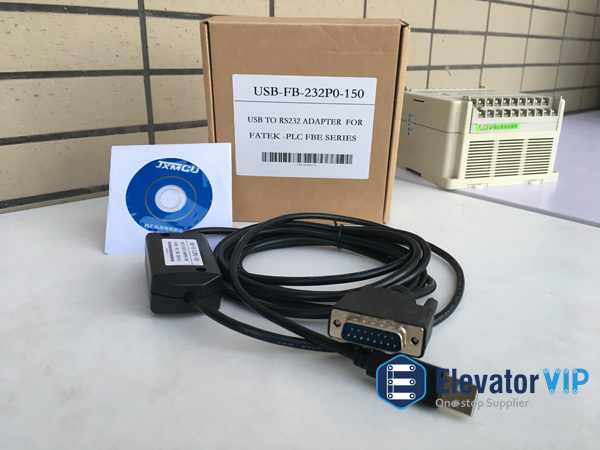
FATEK Communication Cable for FBE and FBS series
(USB-FB-232P0-150 USB TO RS232 ADAPTER FOR FATEK PLC FBE SERIES)
What is the reason for the deviation of escalator steps?
What is the reason for the deviation of escalator steps?
The escalator consists of steps traction chains, step guide rail system, drive device, tension device, and handrail device and metal structure. The structure includes: steps, kick plate, bracket and auxiliary wheel. Escalator is continuous work, therefore, in the stream of people concentrated in public places, shops, railway stations, airports, docks, the place such as buildings and underground railway station, to transport a large number of people in a shorter time, using the escalator has more advantageous than using intermittent working elevator.
The steps are integral and modular. The integral die casting is made of aluminum alloy with high precision, light weight and high processing speed. The modular echelon is composed of steps, kicking plate, supporting frame and other parts, with large weight and poor precision. It is a product of small die-casting capacity and is gradually replaced by integral echelon.
The steps move horizontally at the passenger entrance (for passengers to get on the stairs) and gradually form the steps. The steps fade away near the exit and the steps move horizontally again. These movements are realized by the steps of the main wheel and the auxiliary wheel respectively walking along different steps of the guide way.
Under the escalator room has two springs, is for adjusting the escalator cascade running deviation device, if can’t adjust well, that’s different cascade big chain long, need to change the big chains.
The escalator is generally inclined. A pedestrian standing on one end of an escalator will be automatically taken to the other end of the escalator and the steps will remain level all the way. Escalator step has with cascade synchronous moving in on both sides armrest, fu grip for users. Escalators can always walk in one direction, but most can be controlled by managers according to the needs of time, people and so on. Another type of pedestrian conveyance similar to escalators is the automatic walkway. The main difference between the two is that there are no steps on the automatic pedestrian path. Most only walk on the flat ground, or lean slightly.
The escalator consists of a stairway (variable plate conveyor) and an arm rest (deformed belt conveyor) on both sides. Its main components are cascade, traction chain and sprocket, guide rail system, the main drive system (including motor, speed reducer, brake, and the middle transmission links, etc.) drives main shaft, step and tension device, skeleton, comb plate, escalator handrail system and electrical system, etc. The staircase gradually forms a staircase after horizontal movement towards the passenger entrance (facilitating passengers to ascend the stairs). The steps close to the entrance gradually disappear and the steps move horizontally again. These movements are realized by the steps of the main wheel and the auxiliary wheel respectively walking along different steps of the guide way.
Buy FATEK FACON FBE-28MCT PLC for Replacement Elevator Control System
What is the PLC?
A programmable logic controller, PLC, or programmable controller is a digital computer used for automation of typically industrial electromechanical processes, such as control of machinery on factory assembly lines, amusement rides, or light fixtures. PLCs are used in many machines, in many industries.
What PLC can do for elevator?
PLC can be used to control various industrial machines, including the elevator and escalator control system. Today we are talking about SANYO elevator to use the FATEK FACON FBE-28MCT PROGRAMMABLE CONTROLLER to execute a control command. Also many clients ask Elevator Vip whether have the model FBE-28MCT? Yes, it is. Although this kind of PLC has been around for years, but as a professional who has been deeply involved in the elevator industry for many years, we have such capabilities for our clients to offer it. For details of model FBE-28MCT PLC, please refer to below:
Features of FATEK FBE-28MCT PLC
Parts Name: Programmable Logic Controller
PLC Model: FATEK FACON FBE-28MCT
Input power: 100V~240V AC, 50/60Hz, 30VA
Output power: 24V
Features on the case: indicator lights are 485, BTL, ERR, SINK, SOURCE, POW, and RUN.
Video of FBE-28MCT PLC parts:
Pictures of real FBE-28MCT PLC parts:
If you need Programming Software and User Manual (Fatek PLC Programming Manual) of FBE-28MCT PLC, please contact Elevator Vip.
We also can offer other models are FBE-20MA / 20MAT / FBE-20MC / 20MU / 20MUT / 28EA / 28MA / 28MU / 28MUC / 32EX / 40MA / 40MC / 40MU / FB-2DAS.
How to select SH series of Fuji industrial relays for elevator or escalator?
Relay is divided into AC Relay (voltage AC) and DC Relay (voltage DC), which is used in Electric power industry, due to relay device can be used to cut off main circuit quickly, therefore, it is often used for motor control.
For elevator industry, people usually use the relay to control circuit of elevator on and off, so it is a very important elevator parts. Nowadays, the world’s top 10 famous relay brands are: schneider, ABB, SIEMENS, Mitsubishi, Allen-Bradley, Fuji Electric, Sprecher+Schuh, OMRON, TE Connectivity, EATON. But today we are just discussing Fuji Electric Relay used in the elevator industry.
Bifurcated contacts with excellent electrical conductivity/Fuji SH-4 Relay, SH-5 Relay
Description of SH Series Relays:
SH series industrial relays are designed to increase contact reliability and make them easy to use.
The relays’ highly reliable, bifurcated contacts allow them to be used in low-level circuits of 5V, 3mA.
Various optional function units such as auxiliary contact blocks, coil surge suppression units can be added to the relays, allowing fast and field modification.
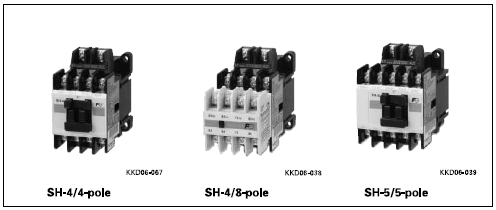
Fuji Relay Model Selection (SH Series)
Types and ratings
| Type | SH-4 | SH-5 | |||||||||||||||||||||||||||||||
| Pole (No. of contacts) | 4-pole | 8-pole | 5-pole | ||||||||||||||||||||||||||||||
| Contact arrangement | 4NO, 3NO+1NC, 2NO+2NC | 8NO, 7NO+1NC, 8NO+2NC 5NO+3NC, 4NO+4NC |
5NO, 4NO+1NC, 3NO+2NC 2NO+3NC, 1NO+4NC, 5NC |
||||||||||||||||||||||||||||||
| Thermal current (A) | 10 | 10 | 10 | ||||||||||||||||||||||||||||||
| Rated operational current (A) |
|
||||||||||||||||||||||||||||||||
| Standard operating coil voltage | 100V 50Hz/100-110V 60Hz, 200V 5OHz/200-220V 60Hz, 380V-400V 50Hz/400-440V 60Hz | ||||||||||||||||||||||||||||||||
| Mechanical durability Electrical durability (AC-15) |
10 million operations 500,000 operations (at operational current) |
||||||||||||||||||||||||||||||||
| Operating cycles per hour | 1,800 | ||||||||||||||||||||||||||||||||
| Ambient temperature | -5 to +50℃ | ||||||||||||||||||||||||||||||||
Ordering code system
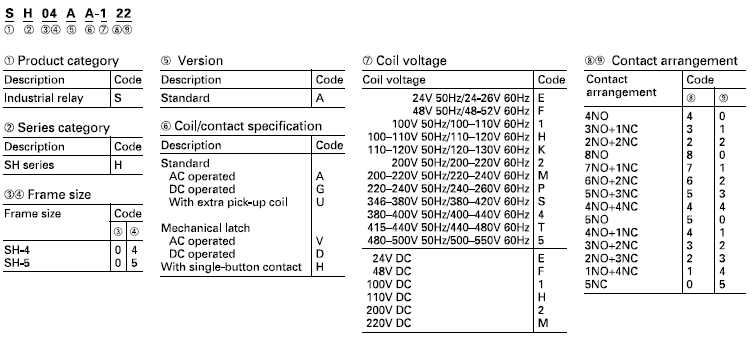
What is the escalator anti-climbing device (Anti-climb Barriers)?
When the escalator is more than 12.5 cm adjacent to the wall, it should be on the escalator or automatic.
A blocking device installed at the upper and lower end of a sidewalk.
Generally, the escalator anti-climbing device on the market is mostly made of acrylic material, and its characteristics are as follows:
- The heat deformation temperature of ordinary acrylic sheets is about 100 degrees, and the continuous use temperature should not be higher than 90 degrees.
- Acrylic sheets are easy to generate static electricity and absorb dust. When cleaning with soft cotton cloth dip 1% soap water can be wiped.
- The surface hardness of acrylic sheets is equivalent to aluminum materials. When used or processed, please be careful to avoid surface scratches. If you get scratched,
The original glossy surface can be restored by polishing.
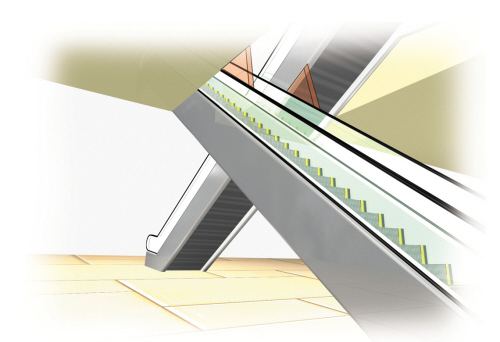
Installation necessity
In public elevators, there are no shortages of children chasing after play. Although many beside the escalators are “forbidden climbing play”, “children must be under adult supervision on” logo, but the installation of the elevator armrests prevent climbing, will also reduce the risk of accidents.
So to go against the wall adjacent to more than 12.5cm, on escalators or sidewalks, bottom department shall install block device, to prevent people from entering the outer cover plate area, thus fall accident, etc.
Method of use
If there is a risk of a person falling, appropriate measures should be taken to prevent the person from climbing onto the outside of the handrail device. In order to ensure this, escalators and moving sidewalks outside cover plate should be installed on the fortification climb the device (see right-hand chart), climbing device located above ground plane h9 (1000 + 50 mm), lower fellowship with outer cover plate, parallel to the outer cover plate on the direction of extension of l5 should not be less than 1000 mm in length, and shall ensure that within the scope of this length without stepping on foot.

